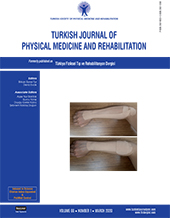Rates, causes, and types of readmissions after total joint arthroplasty
2 Department of Health Institutions Management, Ankara University, Faculty of Health Science, Ankara, Turkey DOI : 10.5606/tftrd.2020.3916 Objectives: The aim of the study was to investigate the causes and rates of readmissions within 90 days after primary and revision knee and hip arthroplasties.
Patients and methods: A total of 1,516 patients (290 males, 1,226 females; mean age 64.7±10.5 years; range, 21 to 91 years) who underwent primary total hip arthroplasty (THA), primary total knee arthroplasty (TKA), revision THA, and revision TKA between January 2013 and December 2014 were retrospectively analyzed. All readmissions within 90 days as of discharge dates of patients were analyzed and were categorized as planned readmissions related to the index admission, unplanned readmissions related to the index admission, planned readmissions unrelated to the index admission and unplanned readmissions unrelated to the index admission.
Results: Readmission rate in the overall of study group was found to be 5.61%. This rate varied depending on the procedure applied, ranging between 2.35 and 6.74%. Unplanned readmissions related to the index admission within 90 days consisted of 60.0% of total readmissions. A total of 82.0% of readmissions within 90 days was due to surgical reasons. Planned readmissions unrelated to the index admission within 90 days were also frequently seen (31.76%). Totally 48.23% of total readmissions within 90 days occurred within the first 30 days. A total of 48.23% of the total readmissions and 58.82% of the readmissions which were unplanned and related to the index admission occurred within the first 30 days.
Conclusion: After knee and hip arthroplasties, readmissions occur due to various reasons. Therefore, it is of utmost importance to identify the readmission type in the evaluation of readmissions which may increase the effectiveness of precautions to be taken.
Keywords : Joint arthroplasty, readmission, readmission type

















